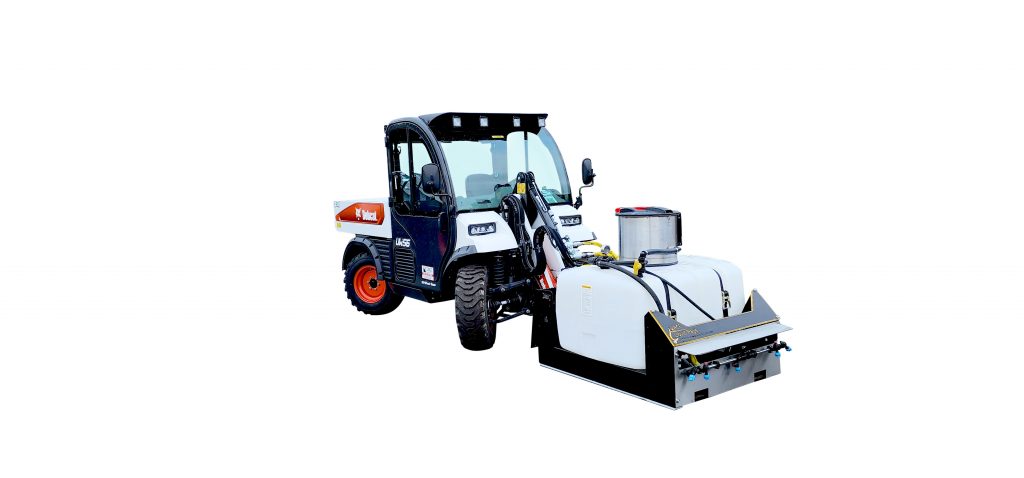Dust suppression is needed in various environments and industries where dust generation poses health, safety, environmental, or operational concerns. Some of the most common places where dust suppression measures are necessary include:
 Construction Sites: Dust is generated during construction activities such as demolition, excavation, grading, and concrete cutting. Dust suppression is essential to protect workers’ health, nearby residents, and to comply with regulations.
Construction Sites: Dust is generated during construction activities such as demolition, excavation, grading, and concrete cutting. Dust suppression is essential to protect workers’ health, nearby residents, and to comply with regulations.- Mines and Quarries: Mining and quarrying operations produce significant amounts of dust from activities like drilling, blasting, crushing, and hauling. Dust suppression is critical to prevent respiratory diseases, maintain air quality, and comply with regulations.
- Industrial Facilities: Industries such as cement manufacturing, steel production, power generation, and chemical processing can generate large amounts of dust from various processes. Dust suppression is required to protect workers, equipment, and surrounding communities.
- Roads and Highways: Unpaved roads, construction sites along roads, and transportation of bulk materials can generate dust that affects air quality, visibility, and road safety. Dust suppression measures are needed to mitigate these impacts.
- Agricultural Operations: Activities like plowing, tilling, harvesting, and livestock handling can produce dust on farms. Dust suppression helps protect workers’ health, livestock, and neighboring communities.
 Equestrian Areas: Competitive and recreational spaces for horseback riding are often areas where the soil is loose – most commonly sand. Sand footing is popular for equestrian arenas and riding surfaces due to its excellent drainage properties, cushioning effect, and consistency. It provides good traction and support for horse hooves, making it suitable for a wide range of disciplines including dressage, jumping, and reining. Additionally, sand footing is relatively easy to maintain through spraying, and can be mixed with additives such as fiber or rubber to improve stability and reduce dust.
Equestrian Areas: Competitive and recreational spaces for horseback riding are often areas where the soil is loose – most commonly sand. Sand footing is popular for equestrian arenas and riding surfaces due to its excellent drainage properties, cushioning effect, and consistency. It provides good traction and support for horse hooves, making it suitable for a wide range of disciplines including dressage, jumping, and reining. Additionally, sand footing is relatively easy to maintain through spraying, and can be mixed with additives such as fiber or rubber to improve stability and reduce dust.- Warehousing and Material Handling: Operations involving storage, handling, and transportation of bulk materials like grains, coal, and minerals can generate dust. Dust suppression is necessary to maintain indoor air quality, prevent explosions, and comply with regulations.
- Public Spaces: Dust suppression may be needed in public spaces such as parks, playgrounds, parking lots, dirt racetracks and recreational areas such as atv trails to improve air quality, reduce allergens, and enhance overall environmental quality.
- Quarantine Facilities: Facilities handling materials prone to producing airborne contaminants, such as hazardous chemicals or biological agents, require dust suppression to maintain containment and protect personnel.

- Residential Areas: Dust suppression measures may be necessary in residential areas unpaved roads and driveway to protect residents’ health and maintain quality of life.
- Sensitive Environments: Dust suppression is crucial in sensitive environments such as wildlife habitats, protected areas, and ecosystems to minimize ecological impacts and preserve biodiversity.
So what are the best ways to suppress dust?
- Water Spraying: One of the simplest and most effective methods, water is sprayed onto dusty surfaces to weigh down the dust particles and prevent them from becoming airborne. This can be done using sprinkler systems, water trucks, or handheld hoses.
- Chemical Dust Suppressants: Chemicals like magnesium chloride, calcium chloride, or lignosulfonates can be applied to surfaces to control dust. These chemicals can absorb moisture from the air, reducing the likelihood of dust becoming airborne.
- Vegetative Cover: Planting vegetation such as grass, shrubs, or trees can help stabilize soil and prevent erosion, reducing dust generation.
- Enclosure and Confinement: Enclosing dusty operations or confining them within structures can prevent dust from spreading into the surrounding environment. This can be achieved through the use of walls, barriers, or buildings.
- Soil Stabilization: Treating soil with stabilizers like polymers, cement, or lime can improve soil structure and reduce dust generation.
- Dust Collection Systems: Installing dust collection systems such as dust collectors, baghouses, or cyclones can capture airborne dust particles before they can spread.
- Windbreaks: Erecting barriers like fences, walls, or windbreak nets can reduce wind speed and prevent it from carrying dust away from the source.
- Vehicle Speed Reduction: Limiting vehicle speeds in dusty areas can help reduce the disturbance of dust on unpaved roads or surfaces.
What’s the best way to apply water or chemical dust suppressants?
Water spraying and chemical dust suppressants are both effective methods for controlling dust, but they have differences in terms of effectiveness, longevity, environmental impact, and cost. The best way to apply these suppressants depends on factors such as the type of suppressant used, the surface area to be treated, and environmental conditions. However, here are some general guidelines for applying dust suppressants effectively:
- Select the Right Suppressant: Choose a chemical dust suppressant that is suitable for the specific dust problem and surface conditions. Different suppressants may be more effective for different types of dust and surfaces.
- Water spraying is highly effective at temporarily suppressing dust by weighing down particles and preventing them from becoming airborne. However, its effectiveness is limited to the duration of moisture retention on the treated surface. Water spraying is generally less expensive than chemical dust suppressants since it only requires water and basic spraying equipment. However, the cost of water usage may vary depending on local water rates and availability.
- Chemical dust suppressants often provide longer-lasting dust control compared to water spraying. They can chemically bind dust particles together or to the surface, reducing their mobility and preventing them from becoming airborne for an extended period. Chemical dust suppressants can be more costly than water spraying due to the purchase of the suppressant chemicals and specialized application equipment. However, their longer-lasting effectiveness may result in cost savings over time.
- Follow Manufacturer’s Instructions: Always follow the manufacturer’s recommendations regarding the proper application rate, dilution ratio (if applicable), and application method for the chosen suppressant.
- Use Appropriate Equipment: Depending on the scale of the application, use appropriate equipment such as sprayers, foggers, or watering trucks to apply the suppressant evenly over the surface.
- Water spraying is relatively simple and can be applied using basic equipment such as hoses, sprinklers, or water trucks. It requires minimal setup and training.
- Applying chemical dust suppressants may require specialized equipment and expertise to ensure proper dilution, mixing, and application. It may involve additional steps such as safety precautions and environmental considerations.
- Uniform Application: Apply the suppressant evenly and uniformly across the entire surface to be treated. Avoid over-application or puddling, as this can lead to runoff and waste of the suppressant.
- Timing: Apply the suppressant when weather conditions are conducive to effective application. Avoid applying suppressants during periods of heavy rain or strong winds, as this can reduce the effectiveness of the treatment.
- The effectiveness of water spraying diminishes relatively quickly as the water evaporates or drains away from the treated surface. It may need frequent reapplication to maintain dust control.
- Chemical dust suppressants can provide longer-lasting dust control, requiring less frequent reapplication compared to water spraying. Some suppressants can remain effective for weeks or even months depending on environmental conditions.
- Consider Environmental Impact: Consider the potential environmental impact of the suppressant and take appropriate measures to minimize runoff and contamination of nearby water bodies or sensitive ecosystems.
- Water spraying has minimal environmental impact since it utilizes only water, which is non-toxic and readily available. However, excessive water usage may lead to runoff and soil erosion in some cases.
- The environmental impact of chemical dust suppressants varies depending on the type of chemicals used. Some suppressants may contain substances that are harmful to the environment or aquatic life, especially if they leach into soil or water bodies.
- Safety Precautions: Take necessary safety precautions when handling and applying chemical dust suppressants, including wearing appropriate personal protective equipment (PPE) and following safety guidelines provided by the manufacturer.
- Monitor Effectiveness: Monitor the effectiveness of the dust suppression treatment over time and reapply the suppressant as needed to maintain optimal dust control.
By following these guidelines and using proper techniques, chemical dust suppressants can be applied effectively to control dust and improve air quality in various environments. Both water spraying and chemical dust suppressants have their advantages and disadvantages depending on the specific needs and circumstances of dust control applications. Water spraying is simple, cost-effective, and environmentally friendly but may require more frequent reapplication. Chemical dust suppressants offer longer-lasting dust control but may involve higher costs and environmental considerations.
What does KAGE offer for dust suppression?
 KAGE Innovation’s LiquidRage sprayer is great for dust suppression whether using water or brine dust suppressants. This 150-gallon-tank sprayer can cover anywhere up to 30-foot swaths in a single pass and easily attaches to skid steers, ag tractors and ATV’s without needing separate attachment adaptors. It’s unique attachment plate accommodates both 3-point hitches and universal skid steer attachments. The LiquidRage is a boomless sprayer that can also be equipped with an optional hose reel and spray wand when more precision work is necessary. And if you’re using brine, KAGE also offers a brine mixer that attaches to the top of the tank.
KAGE Innovation’s LiquidRage sprayer is great for dust suppression whether using water or brine dust suppressants. This 150-gallon-tank sprayer can cover anywhere up to 30-foot swaths in a single pass and easily attaches to skid steers, ag tractors and ATV’s without needing separate attachment adaptors. It’s unique attachment plate accommodates both 3-point hitches and universal skid steer attachments. The LiquidRage is a boomless sprayer that can also be equipped with an optional hose reel and spray wand when more precision work is necessary. And if you’re using brine, KAGE also offers a brine mixer that attaches to the top of the tank.
What kind of brines can be used for dust suppression?
Several types of brines are used for dust suppression, each with its own composition and specific application. The following are effective at suppressing dust on unpaved driveway, parking lots, roads, construction sites, and other dusty surfaces.
- Calcium Chloride (CaCl2):
- Calcium chloride brine is one of the most commonly used dust suppressants. It is hygroscopic, meaning it attracts moisture from the air, which helps to keep road surfaces damp and prevent dust from becoming airborne.
- CaCl2 brine is often preferred for its ability to work at lower temperatures compared to other brines, making it suitable for use in colder climates.
- Magnesium Chloride (MgCl2):
- Magnesium chloride brine is another popular choice for dust suppression. Similar to calcium chloride, it is hygroscopic and helps to retain moisture on treated surfaces.
- MgCl2 brine is often used as an alternative to calcium chloride, especially in areas where environmental concerns or cost considerations favor magnesium-based products.
- Salt Brine (NaCl):
- Salt brine, made from sodium chloride (table salt) and water, is also used for dust suppression, particularly in regions where salt is readily available and cost-effective. Salt brine works by attracting moisture from the air, which helps to keep surfaces damp and reduce dust.
- Lignosulfonate Brine:
- Lignosulfonate is a byproduct of the paper industry and is sometimes used as a dust suppressant. It works by binding fine particles together, preventing them from becoming airborne.
- Lignosulfonate brine is often used in areas where environmental concerns or regulations restrict the use of chemical brines like calcium chloride or magnesium chloride.
- Organic Brines:
- Some organic compounds can be used to create environmentally friendly brines for dust suppression. These may include biodegradable polymers or natural extracts.
- Organic brines are often used in sensitive environmental areas where traditional chemical brines may have adverse effects on local ecosystems.
These are just a few examples of the types of brines used for dust suppression. The choice of brine depends on factors such as local availability, cost, effectiveness, environmental considerations, and specific application requirements.





Recent Comments